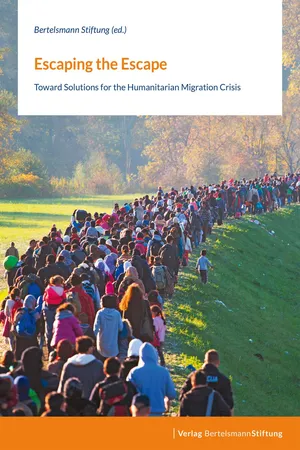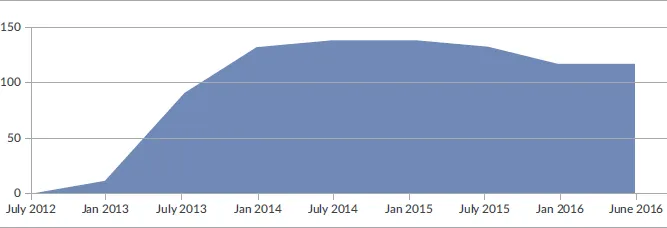
Escaping the Escape
Toward Solutions for the Humanitarian Migration Crisis
- 360 pages
- English
- ePUB (mobile friendly)
- Available on iOS & Android
About this book
Conflict and war, but most of all overwhelming despair are driving massive numbers of mostly young people from the Middle East and North Africa, Central Africa, the Balkan, Ukraine and Central Asia to leave their homes for Europe in search of safety. What do they need most in order to lead their lives in peace and security? How can opportunities for a meaningful and secure future in their countries of origin be improved? How can the EU – acting in concert with its principles – support these people in their search for freedom, self-determination and well-being? These are the questions addressed in "Escaping the Escape." The publication features authors from refugee-source countries and experts from Europe who examine the situation in the crisis regions and offer concrete recommendations for actions to be taken in each region.Countries and regions covered in this publication are: Afghanistan, Algeria and Sahel, the Balkans, Egypt, Eritrea, Gaza, Greece, Iran, Iraq, Jordan, Lebanon, Libya, Morocco, Nigeria, Somalia, South Sudan, Sudan, Syria, Tunisia, Turkey, Ukraine, Yemen.
Frequently asked questions
- Essential is ideal for learners and professionals who enjoy exploring a wide range of subjects. Access the Essential Library with 800,000+ trusted titles and best-sellers across business, personal growth, and the humanities. Includes unlimited reading time and Standard Read Aloud voice.
- Complete: Perfect for advanced learners and researchers needing full, unrestricted access. Unlock 1.4M+ books across hundreds of subjects, including academic and specialized titles. The Complete Plan also includes advanced features like Premium Read Aloud and Research Assistant.
Please note we cannot support devices running on iOS 13 and Android 7 or earlier. Learn more about using the app.
Information
Human Mobility in the Euro-Mediterranean Region: The Case of Egypt


Basic facts | Egypt |
Capital | Cairo |
Demographics | |
Population | 91.51 million |
Annual population growth rate | 2.1 % |
Net migration rate (2016 est.) | -0.5 migrant(s)/1,000 population |
Top destination countries (2013) | Saudi Arabia, Kuwait, the United Arab Emirates, Jordan, the United States of America, Qatar, Italy, Lebanon, Bahrain, Canada |
Top source countries (2013) | Syria, West Bank and Gaza, Somalia, Iraq, Saudi Arabia, Republic of Yemen, Libya, Jordan, Sudan, Indonesia |
Ethnic groups | Egyptian 99.6 %, other 0.4 % (2006) |
Languages | Arabic (official), English and French widely understood by educated classes |
Religions and beliefs | Muslim (predominantly Sunni) 90 %, Christian (majority Coptic Orthodox, other Christians include Armenian Apostolic, Catholic, Maronite, Orthodox and Anglican) 10 % (2012 est.) |
Median age (2016 est.) | 23.8 years |
Economy and employment | |
GDP, PPP / GDP per capita, PPP | $ 996.638 billion / $ 10,891.3 |
GDP growth rate | 4.2 % |
GNI, PPP / GNI per capita, PPP | $ 978.332 billion / $ 10,690 |
Inflation rate (consumer prices) | 10.4 % |
Unemployment (%) (2014) | 13.2 % (2014) |
Youth (15-24 years) unemployment (2014) | 42 % (2014) |
FDI inflows | $ 6.885 billion |
Imports of goods and services | $ 73.675 billion (2014) |
Exports of goods and services | $ 47.101 billion (2014) |
Remittances inward flow | $ 20.391 billion |
Political transformation (BTI 2016) | 3.93 (rank 91 out of 129 countries) |
Economic transformation (BTI 2016) | 4.86 (rank 83 out of 129 countries) |
Reasons for flight: Policy failures, conflicts and war
1. Syrian refugees in Egypt
Date | Number of registered refugees | Absolute change |
July 2012 | 924 | --- |
Jan 2013 | 13,001 | 12,077 |
July 2013 | 88,960 | 75,959 |
Jan 2014 | 131,599 | 42,639 |
July 2014 | 138,159 | 6,560 |
Jan 2015 | 138,212 | 53 |
July 2015 | 132,375 | -5,837 |
Jan 2016 | 117,658 | -14,717 |
June 2016 | 117,702 | 44 |

2. Other refugee populations in Egypt
Table of contents
- Cover
- Titel
- Impressum
- Inhalt
- Foreword
- Preface
- A Note from the Editors
- On the Far Side of Crisis: Moving Beyond a Security-Based Migration Approach in the EU
- Greece: Both A Transit and Host Country
- The Balkans as Europe’s Blind Spot: A Transit Route and Migrant-Origin Area
- Migration, Refugees and Internal Displacement in Ukraine
- Turkey as a Refugee Transit and Host Country
- Afghanistan: Current Migration Patterns and Policy Challenges
- Iran and the Immigration Crisis: Examining the Causes and Consequences of Afghan Immigration
- Emigration from Iraq: Who Wants to Leave and Why?
- The Syrian Crisis and Flow of the Syrian Refugees
- On the Situation of Syrian Refugees in Jordan and Lebanon
- Human Mobility in the Euro-Mediterranean Region: The Case of Egypt
- The Gaza Strip: Reversing the Desire to Flee
- The Refugee Crisis and Yemen: Prospects for and Conditions of Improvement
- Irregular Somali Immigration to the EU: Causes and Remedies
- Eritrea – National Service, Forced Labor and Mass Exodus: Is There a Way Out?
- More Effective Options in Addressing Irregular Sudanese and South Sudanese Migration to Europe
- A Look Deep Inside Nigeria’s Migration Conundrums
- Irregular Migration in Libya: Analysis, Facts and Recommendations
- Migration Flows from Tunisia: Analysis of Socioeconomic Causes in the Post-Revolutionary Period
- Migration and Refugees in Algeria and the Sahel: Targeting a Win-Win Neighborhood Policy in the Mediterranean
- Morocco as an Origin, Transit and Host Country for Migrants
- Escaping the Escape – A Résumé
- The Authors
- Migration routes to Europe and within Africa
- Political transformation
- Selected demographics data: share of persons older than 65 years, youth unemployment